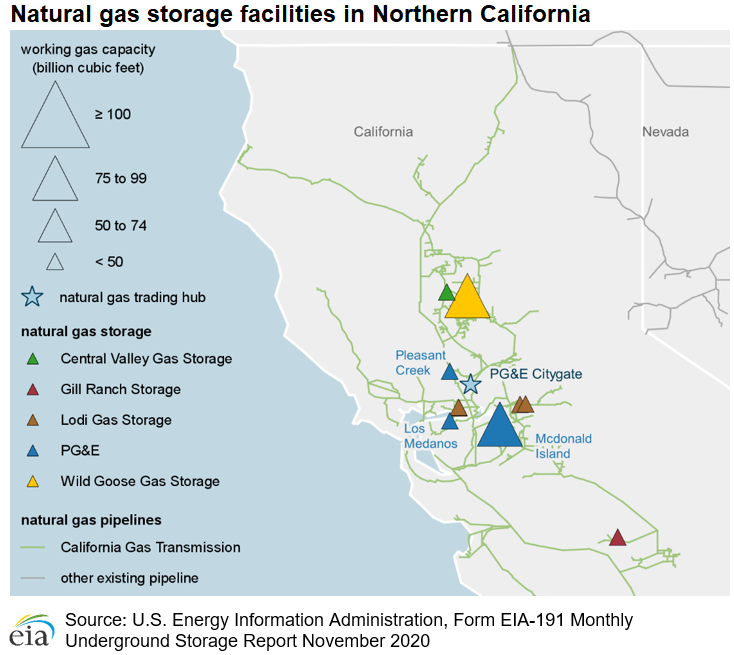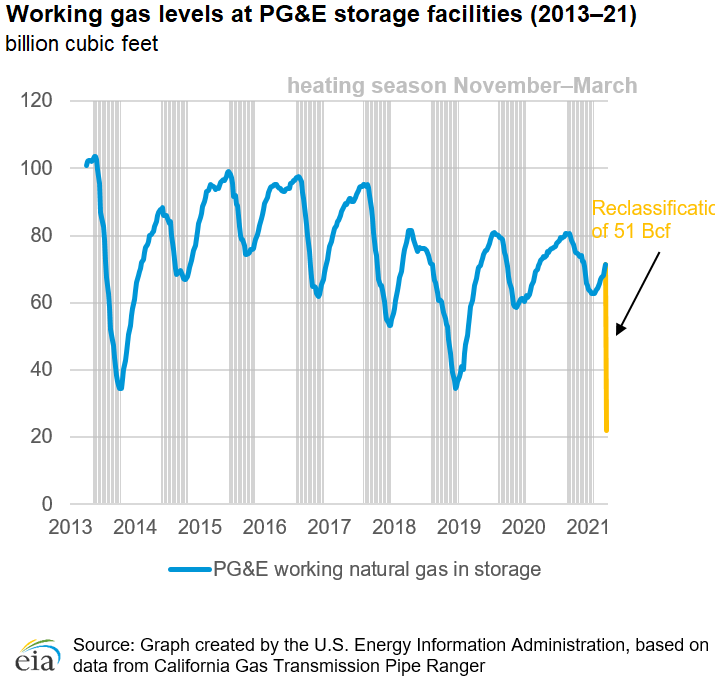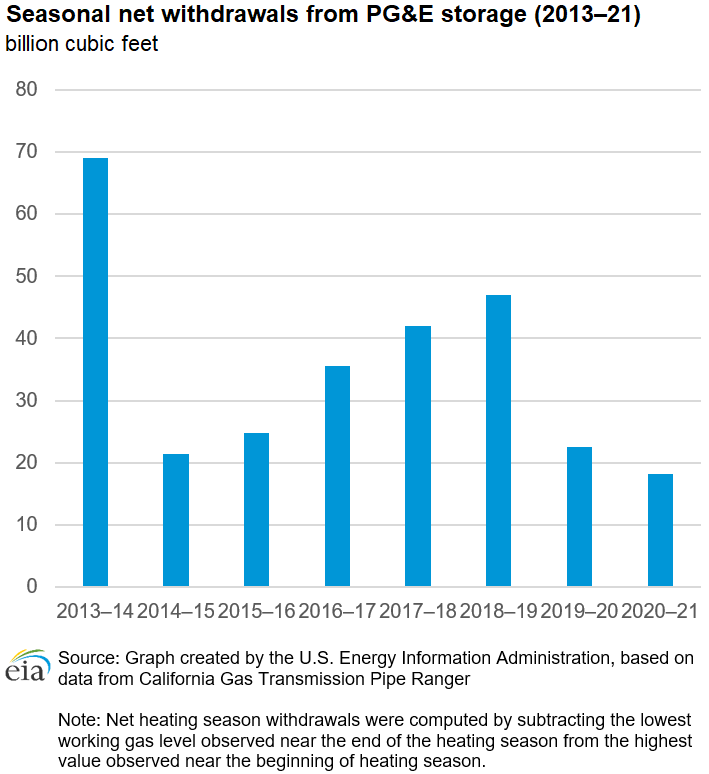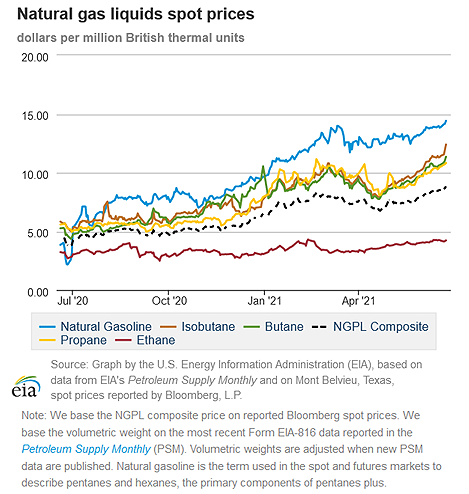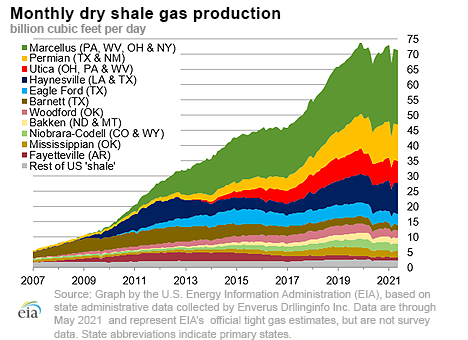In the News:
Pacific Gas and Electric reports reclassification of working gas levels at their natural gas storage facilities in Northern California
Pacific Gas and Electric (PG&E) reported a reclassification of 51 billion cubic feet (Bcf) of working natural gas storage (the amount of natural gas in storage that is available for withdrawal) to base gas as of June 11, 2021. The 51 Bcf reclassification —was the largest single day reduction in working gas ever reported at the PG&E storage facility, and it exceeded the total heating season (November–March), net withdrawals reported in any heating season since the 2013–14 heating season. As a result of this change, reported inventory at the PG&E natural gas storage facilities declined from 72.9 Bcf to 22.0 Bcf as of June 11.
Although the reclassification resulted in a large decrease in working gas levels in the Pacific region for the week ending June 11, the reclassification is a non-flow related change that has no effect on the total natural gas in storage (base gas plus working gas). In fact, the withdrawal activity at PG&E storage facilities suggests that a significant portion of the working gas in storage has not been withdrawn or cycled in recent years. Since the 2013–14 heating season when 69 Bcf was withdrawn from working natural gas, net seasonal withdrawals have not exceeded 47 Bcf. Moreover, working gas levels at these fields never fell below 34 Bcf, suggesting that some of the working natural gas inventory was effectively acting as base gas even before the reclassification formalized the change.
Prior to the reclassification, PG&E’s working gas capacity totaled 102 Bcf at three natural gas storage fields: McDonald Island (82 Bcf), Pleasant Creek (2.3 Bcf,) and Los Medanos (17.9 Bcf). At 102 Bcf, PG&E was the 10th largest storage operator in the United States, and the McDonald Island field was the 8th largest storage field in terms of working gas capacity. After the reclassification, PG&E’s working gas capacity still exceeds 51 Bcf.
The reclassification is part of a permanent shift in how PG&E will operate its natural gas storage fields: using natural gas storage to ensure system reliability rather than as a commodity price management tool. In its application to the California Public Utilities Commission (CPUC), PG&E cited changing market conditions—such as seasonal price differentials that have been narrowing and regulatory changes that would require significant new capital investments in their fields—as the reason for the reassessment. This narrower operational mission means that PG&E can serve its customers with fewer natural gas storage assets. Under this plan, other storage operators in the region, such as Wild Goose, Central Valley, and Lodi, will continue to provide commodity price management services. Working natural gas storage capacity at those three facilities total almost 135 Bcf. In addition to maintaining larger base gas levels in its facilities to ensure deliverability, PG&E plans to sell or decommission the Pleasant Creek and Los Medanos fields in 2021. The CPUC approved this plan in September 2019.
Overview:
(For the week ending Wednesday, June 23, 2021)
- Natural gas spot prices rose at most locations this report week (Wednesday, June 16 to Wednesday, June 23). The Henry Hub spot price rose from $3.17 per million British thermal units (MMBtu) last Wednesday to $3.33/MMBtu yesterday.
- The price of the July 2021 NYMEX contract increased 8¢ from $3.251/MMBtu last Wednesday to $3.333/MMBtu yesterday. The price of the 12-month strip averaging July 2021 through June 2022 futures contracts climbed 5¢/MMBtu to $3.259/MMBtu.
- The net injections to working gas totaled 55 billion cubic feet (Bcf) for the week ending June 18. Working natural gas stocks totaled 2,482 Bcf, which is 17% lower than the year-ago level and 6% lower than the five-year (2016–2020) average for this week.
- The natural gas plant liquids composite price at Mont Belvieu, Texas, the main pricing and storage hub for hydrocarbon gas liquids on the Gulf Coast, rose by 18¢/MMBtu and averaged $8.63/MMBtu for the week ending June 23. Ethane prices fell 1%, which is less than the 3% price decrease in natural gas at the Houston Ship Channel. Propane and butanes prices rose 3%—a larger increase than the 2% price increase for Brent crude oil. Natural gasoline prices rose 1%.
- According to Baker Hughes, for the week ending Tuesday, June 15, the natural gas rig count increased by 1 to 97. The number of oil-directed rigs rose by 8 to 373. The total rig count increased by 9, and it now stands at 470, a 78% increase over this time last year.
Prices/Supply/Demand:
Gulf Coast prices rise as demand for natural gas for electricity generation remains high. This report week (Wednesday, June 16 to Wednesday, June 23), the Henry Hub spot price rose 16¢ from $3.17/MMBtu last Wednesday to its high for the week of $3.33/MMBtu yesterday. Due to higher-than-normal temperatures last week and early into this report week, net electricity generation in the Electric Reliability Council of Texas (ERCOT) region was the highest since the region experienced severe winter temperatures in February, and natural gas was the leading energy source amid declines in wind generation. Prices in Katy, Texas, also increased this report week from $3.21/MMBtu to $3.32/MMBtu.
Drought conditions in the West increases demand for natural gas for electricity generation. The price at PG&E Citygate in Northern California rose 18¢ from $4.69/MMBtu last Wednesday to $4.87/MMBtu yesterday. Natural gas demand for power generation in the Pacific Northwest increased 21% this report week according to data from IHS Markit as extreme heat and drought conditions continue to limit hydroelectric generation in the region. The price at Opal Hub in Southwest Wyoming also increased from $3.38/MMBtu last Wednesday to $3.45/MMBtu yesterday. The price at SoCal Citygate in Southern California was volatile this report week, decreasing $1.57 from $5.66/MMBtu last Wednesday to $4.09/MMBtu yesterday after reaching a weekly high of $6.16 on Thursday. Following four days of consecutive withdrawals (June 15–18), Southern California Gas (SoCalGas) storage levels are now 0.8 Bcf below where they were this time last year.
Midwest prices increase moderately after declining early in the week. At the Chicago Citygate, the price increased 5¢ from $3.11/MMBtu last Wednesday to $3.16/MMBtu yesterday after reaching a weekly low of $3.01/MMBtu on Monday. Temperatures in the Midwest this report week were moderate compared with last week, ranging from an average of 64°F on Tuesday to an average of 79°F last Friday in Chicago. According to data from IHS Markit, natural gas consumption for power generation in the Midwest decreased more than 1 Bcf/d this report week compared with the previous week.
Northeast prices increase along with demand. At the Algonquin Citygate, which serves Boston-area consumers, the price went up 26¢ from $2.36/MMBtu last Wednesday to $2.62/MMBtu yesterday. At the Transcontinental Pipeline Zone 6 trading point for New York City, the price increased 15¢ from $2.30/MMBtu last Wednesday to $2.45/MMBtu yesterday. According to data from IHS Markit, consumption in New England increased 15% week over week. Consumption in the New York and New Jersey areas increased 11%, primarily in the electric power sector.
Appalachia Basin prices increase. The Tennessee Zone 4 Marcellus spot price increased 47¢ from $1.92/MMBtu last Wednesday to $2.39/MMBtu yesterday. The price at Eastern Gas South (formerly known as Dominion South until June 1, 2021) in Southwestern Pennsylvania rose 35¢ from $2.11/MMBtu last Wednesday to $2.46/MMBtu yesterday.
Prices in the Permian Basin production region increase as a force majeure is declared. The price at the Waha Hub in West Texas, which is located near Permian Basin production activities, averaged $3.04/MMBtu last Wednesday, 13¢/MMBtu lower than the Henry Hub price. Yesterday, the price at the Waha Hub averaged $2.66/MMBtu, 67¢/MMBtu lower than the Henry Hub price. All West Texas and Southeast New Mexico natural gas price points fell similarly with respect to Henry Hub prices after a force majeure was declared on the El Paso Natural Gas pipeline with no estimated return date.
U.S. natural gas production increases slightly. According to data from IHS Markit, the average total supply of natural gas fell by 0.1% compared with the previous report week. Dry natural gas production grew by 0.2% compared with the previous report week and continues to remain at or above the five-year (2016–2020) range of dry natural gas production. Average net imports from Canada decreased by 6.6% compared with last week, from 5.0 Bcf/d to 4.7 Bcf/d, and both volumes remain well within the five-year average.
U.S. natural gas exports to Mexico reach record highs. Total U.S. consumption of natural gas fell by 1.8% compared with the previous report week, according to data from IHS Markit. High temperatures continued west of the U.S. Rocky Mountains but approached normal this week for the rest of the United States. In response to overall lower air conditioning demand, natural gas consumed for power generation declined by 4.3% week over week. Industrial sector consumption increased by 0.6% week over week. In the residential and commercial sectors, consumption increased by 3.4%. Natural gas exports to Mexico increased 3.0% to 7.0 Bcf/d, a record weekly average according to data from IHS Markit. Natural gas deliveries to U.S. liquefied natural gas (LNG) export facilities (LNG pipeline receipts) continued at levels well above the five-year high, averaging 10.0 Bcf/d, or 0.54 Bcf/d higher than last week.
U.S. LNG exports decrease week over week. Seventeen LNG vessels (five from Sabine Pass, four each from Freeport and Corpus Christi, two from Cameron, and one each from Cove Point and Elba Island) with a combined LNG-carrying capacity of 62 Bcf departed the United States between June 17 and June 23, 2021, according to shipping data provided by Bloomberg Finance, L.P.
Storage:
The net injections into storage totaled 55 Bcf for the week ending June 18, compared with the five-year (2016–2020) average net injections of 83 Bcf and last year's net injections of 115 Bcf during the same week. Working natural gas stocks totaled 2,482 Bcf, which is 154 Bcf lower than the five-year average and 513 Bcf lower than last year at this time.
According to The Desk survey of natural gas analysts, estimates of the weekly net change to working natural gas stocks ranged from net injections of 54 Bcf to 78 Bcf, with a median estimate of 62 Bcf.
The average rate of injections into storage is 15% lower than the five-year average so far in the refill season (April through October). If the rate of injections into storage matched the five-year average of 8. Bcf/d for the remainder of the refill season, the total inventory would be 3,565 Bcf on October 31, which is 154 Bcf lower than the five-year average of 3,719 Bcf for that time of year.
More storage data and analysis can be found on the Natural Gas Storage Dashboard and the Weekly Natural Gas Storage Report.
See also:
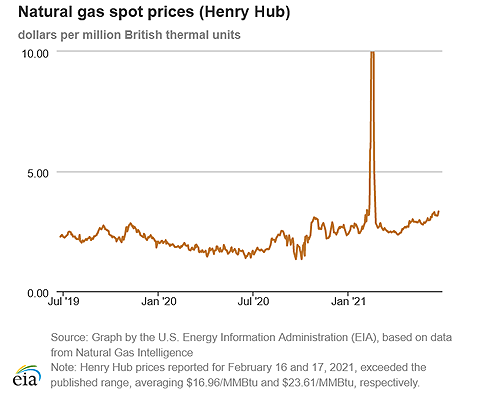
| Spot Prices ($/MMBtu) | Thu, 17-Jun |
Fri, 18-Jun |
Mon, 21-Jun |
Tue, 22-Jun |
Wed, 23-Jun |
|---|---|---|---|---|---|
| Henry Hub |
3.20 |
3.16 |
3.15 |
3.22 |
3.33 |
| New York |
2.49 |
2.68 |
2.59 |
2.59 |
2.45 |
| Chicago |
3.12 |
3.08 |
3.01 |
3.06 |
3.16 |
| Cal. Comp. Avg.* |
4.19 |
3.88 |
4.12 |
4.09 |
4.06 |
| Futures ($/MMBtu) | |||||
| July contract | 3.253 |
3.215 |
3.191 |
3.258 |
3.333 |
| August contract |
3.275 |
3.236 |
3.215 |
3.277 |
3.352 |
| *Avg. of NGI's reported prices for: Malin, PG&E Citygate, and Southern California Border Avg. | |||||
| Source: NGI's Daily Gas Price Index | |||||
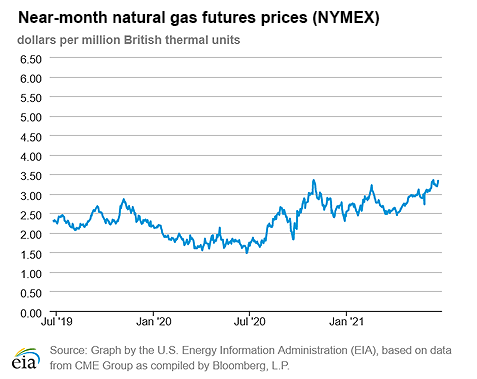
| U.S. natural gas supply - Gas Week: (6/17/21 - 6/23/21) | |||
|---|---|---|---|
Average daily values (billion cubic feet) |
|||
this week |
last week |
last year |
|
| Marketed production | 105.1 |
104.7 |
99.2 |
| Dry production | 93.0 |
92.8 |
88.0 |
| Net Canada imports | 4.7 |
5.0 |
4.0 |
| LNG pipeline deliveries | 0.1 |
0.1 |
0.1 |
| Total supply | 97.8 |
97.9 |
92.2 |
|
Source: Chart by the U.S. Energy Information Administration (EIA), based on data from IHS Markit | |||
| U.S. natural gas consumption - Gas Week: (6/17/21 - 6/23/21) | |||
|---|---|---|---|
Average daily values (billion cubic feet) |
|||
this week |
last week |
last year |
|
| U.S. consumption | 63.3 |
64.4 |
64.2 |
| Power | 34.7 |
36.3 |
35.1 |
| Industrial | 20.4 |
20.2 |
20.2 |
| Residential/commercial | 8.2 |
7.9 |
9.0 |
| Mexico exports | 7.0 |
6.8 |
5.5 |
| Pipeline fuel use/losses | 6.2 |
6.3 |
6.1 |
| LNG pipeline receipts | 10.0 |
9.4 |
3.8 |
| Total demand | 86.5 |
86.9 |
79.6 |
|
Source: Chart by the U.S. Energy Information Administration (EIA), based on data from IHS Markit | |||
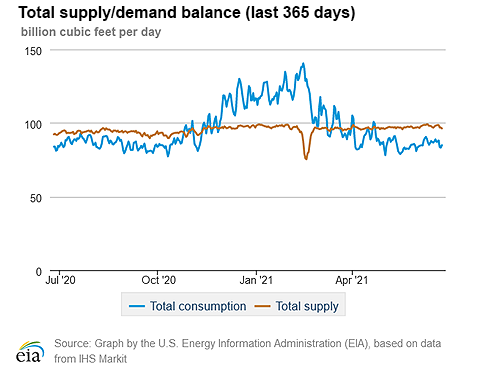
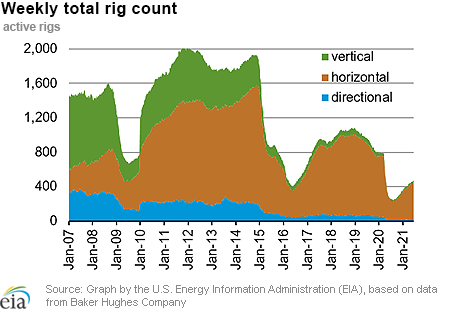
| Rigs | |||
|---|---|---|---|
Tue, June 15, 2021 |
Change from |
||
last week |
last year |
||
| Oil rigs | 373 |
2.2% |
97.4% |
| Natural gas rigs | 97 |
1.0% |
29.3% |
| Note: Excludes any miscellaneous rigs | |||
| Rig numbers by type | |||
|---|---|---|---|
Tue, June 15, 2021 |
Change from |
||
last week |
last year |
||
| Vertical | 20 |
17.6% |
42.9% |
| Horizontal | 425 |
1.2% |
81.6% |
| Directional | 25 |
4.2% |
38.9% |
| Source: Chart by the U.S. Energy Information Administration (EIA), based on data from Baker Hughes Company | |||
| Working gas in underground storage | ||||
|---|---|---|---|---|
Stocks billion cubic feet (Bcf) |
||||
| Region | 2021-06-18 |
2021-06-11 |
change |
|
| East | 488 |
461 |
27 |
|
| Midwest | 595 |
570 |
25 |
|
| Mountain | 169 |
165 |
4 |
|
| Pacific | 239 |
236 C |
3 |
|
| South Central | 991 |
995 |
-4 |
|
| Total | 2,482 |
2,427 C |
55 |
|
|
Source: U.S. Energy Information Administration Form EIA-912, Weekly Underground Natural Gas Storage Report C=Reclassification Note: Reclassifications from working gas to base gas resulted in decreased working gas stocks of 51 Bcf in the Pacific region for the week ending June 11, 2021. The implied flow for the week is an increase of 67 Bcf to working gas stocks. | ||||
| Working gas in underground storage | |||||
|---|---|---|---|---|---|
Historical comparisons |
|||||
Year ago (6/18/20) |
5-year average (2016-2020) |
||||
| Region | Stocks (Bcf) |
% change |
Stocks (Bcf) |
% change |
|
| East | 614 |
-20.5 |
530 |
-7.9 |
|
| Midwest | 712 |
-16.4 |
607 |
-2.0 |
|
| Mountain | 164 |
3.0 |
159 |
6.3 |
|
| Pacific | 298 |
-19.8 |
277 |
-13.7 |
|
| South Central | 1,206 |
-17.8 |
1,063 |
-6.8 |
|
| Total | 2,995 |
-17.1 |
2,636 |
-5.8 |
|
| Source: U.S. Energy Information Administration Form EIA-912, Weekly Underground Natural Gas Storage Report | |||||
| Temperature – heating & cooling degree days (week ending Jun 17) | ||||||||
|---|---|---|---|---|---|---|---|---|
HDDs |
CDDs |
|||||||
| Region | Current total |
Deviation from normal |
Deviation from last year |
Current total |
Deviation from normal |
Deviation from last year |
||
| New England | 18 |
4 |
0 |
5 |
-7 |
-6 |
||
| Middle Atlantic | 7 |
-2 |
-5 |
12 |
-13 |
-11 |
||
| E N Central | 5 |
-7 |
-16 |
48 |
15 |
28 |
||
| W N Central | 0 |
-10 |
-8 |
77 |
34 |
29 |
||
| South Atlantic | 0 |
-2 |
-3 |
79 |
6 |
8 |
||
| E S Central | 0 |
-1 |
-2 |
85 |
17 |
26 |
||
| W S Central | 0 |
0 |
0 |
124 |
24 |
34 |
||
| Mountain | 4 |
-19 |
-8 |
87 |
35 |
38 |
||
| Pacific | 7 |
-10 |
-5 |
41 |
19 |
26 |
||
| United States | 4 |
-6 |
-7 |
61 |
13 |
18 |
||
|
Source: Chart by the U.S. Energy Information Administration (EIA), based on data from the National Oceanic and Atmospheric Administration Note: HDDs=heating degree days; CDDs=cooling degree days | ||||||||
Average temperature (°F)
7-day mean ending Jun 17, 2021
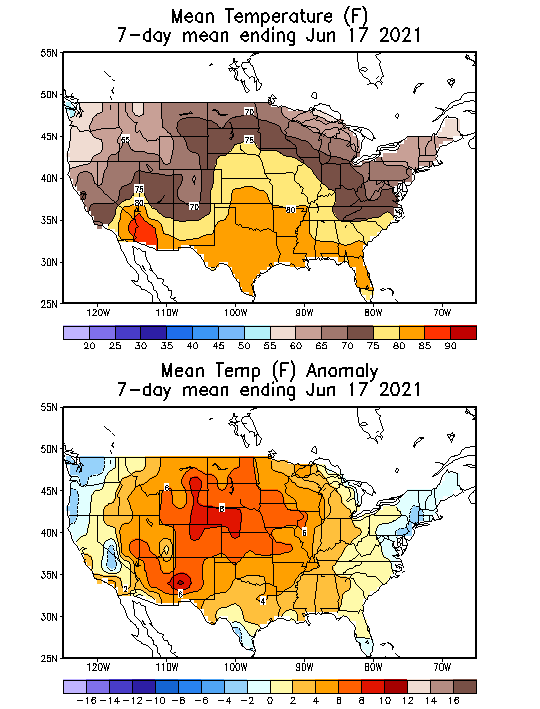
Source: National Oceanic and Atmospheric Administration
Deviation between average and normal (°F)
7-day mean ending Jun 17, 2021

Source: National Oceanic and Atmospheric Administration

